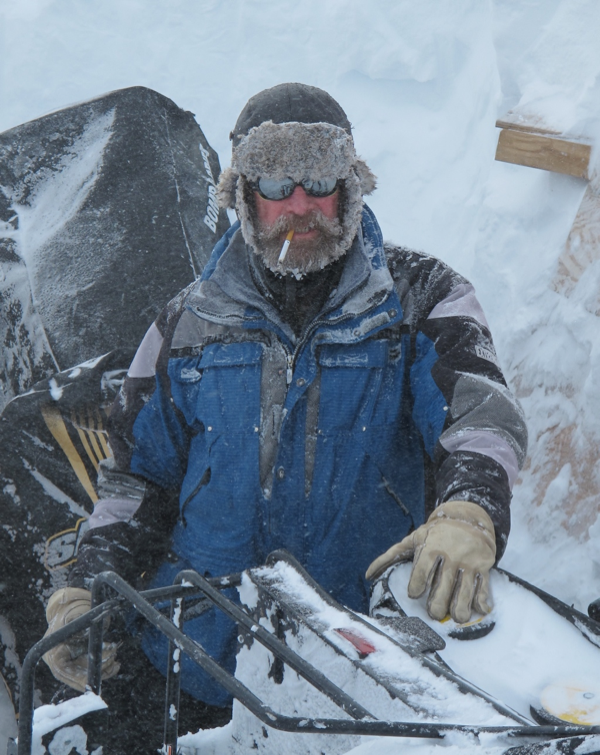
The most striking thing about Konrad Steffen is not his accolades as one of the world’s leading cryosphere researchers, but how he could light a cigarette in a 60-mile-per-hour gale screaming across the ice. He’d duck into his shoulder with a lighter and in a second or two reappear with a glowing cherry. He held the cigarette with his teeth so it wouldn’t blow away.
Koni, as he was known, was as much a vivid, epic character as he was a steadfast climate scientist ringing the alarm that Greenland ice is departing much quicker than expected or modeled. He ran a small research camp built in 1990 on the Greenland Ice Sheet where his monitoring stations have directly tied warming episodes to ice movement as it spills toward the sea.
This was where he died a little over a week ago. He was last seen at his camp walking off to perform a task on the ice, and he never returned. It appears that he fell into a crevasse and drown in the meltwater below. He was 68.
His passing has been heard around the world. In a New York Times article reporting his death, a colleague called Koni a “larger than life explorer-scientist that you typically only get the chance to read about.” Al Gore tweeted, “I am deeply saddened to learn of Koni Steffen’s tragic death in a crevasse near Swiss Camp, on the top of Greenland. I send my love to his family. Koni’s renowned work as a glaciologist has been instrumental in the world’s deepened understanding of the climate crisis.”
I had the privilege of spending time with Koni at his meteorological base station several years ago. I wrote a post about digging out his snowpacked desk. We had long days of shoveling and working on equipment damaged by winter storms, and evenings in a quonset tent around a table, Koni uncorking a bottle of red and pouring into each of our glasses. He saw researchers come and go, opening his camp to climate scientists from around the world. He’d talk about how Alfred Wegner, the German scholar who first proposed the theory of continental drift in 1915, disappeared near here and his body was never found.
Digging buried gear out of the snow, I stopped for a break and climbed out of a trench. Visibility seemed gone, wind howling nonstop for days, temperature well below zero. The only thing I could see was Koni taking a break from his own trench, perched on blocky snow piles. He was smoking, facing east into the wind, his hands jammed into the pockets of his shell.
“Is it always like this?” I shouted.
Koni glanced my way and lifted his cigarette with rawboned fingers, knuckles as big and square as dice. Working hands. He could keep his hands out for a few seconds, five at most, before he had to hide them again. “It’s often like this, yes,” he said. “In the winter it’s much worse, though.”
He told me he overwintered twice in the Arctic, alone in a tent. When I asked if the solitude and elemental isolation got to him he seemed unfazed and instead described the privilege of being able to observe such a dynamic place in its many moods, only him and a sea of ice and snow. He explained the dark of winter, how the air would freeze, any moisture turned into flecks of ice floating around him, glittering in his light on nights as still as breath. I imagine him out there, the only light for countless horizons, peering around at magic in the air.
Zurich-born, where he received his Ph.D. in 1984 at the Swiss Federal Institute of Technology, Koni became a scientist at a time when basic knowledge about how ice masses behave was being overturned. He said that ice sheets had been seen as static, their fluctuations taking centuries. He discovered at his camp that one warm day could significantly accelerate the movement of the entire ice sheet. He didn’t strike me as an alarmist, but a pragmatist. He saw the planet’s ice coming apart at the seams, and it was clear to him humans had the greatest hand in its undoing, but his voice remained steady, thoughtful. “We don’t want to panic,” he said. “People never do well panicking.”
From my brief time with Koni, either clutched to him as he piloted a Ski-Doo across infinite ice, or digging beside him to find buried equipment, I understood him as a tactile scientist. He basked in his element, fascinated by fluid polar shapes, wind twisting around him, drifts forming at his boots.
It seems trite to say he was one with his landscape. It was clear, at least, how Koni loved the place. He told me over and over to be safe out there, reminding me that this is serious terrain, it’ll kill you in a snap. He wasn’t wrong. It was exactly the country he described, so changing and dangerous it both gave him his life and it took it away.
Photo: Craig Childs
Your essay on the passing of Steffen reminds me of a meditation on the death of one explorer of Antarctica that appeared in Scientific American in 1913: “In the desolate, isolate waste of an unexplored Antarctic country Capt. Robert Falcon Scott gave up his life, after having reached the South Pole. He died a true hero of science. There was no buried treasure to seek in those untrodden southern snows–nothing but everlasting fame. Only those who are engaged in scientific research can understand the ideals of a man who willingly cuts himself off from the world for a period of three years and perishes in a blizzard–for what? For meteorological information, for geological data, for light on the fauna and flora of a cold, white, silent land that will probably never be peopled, in a word, for things that are infinitely removed from gold hunting.”